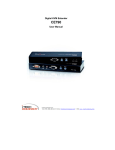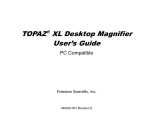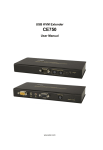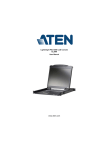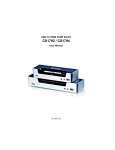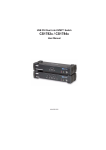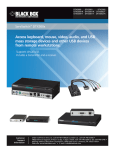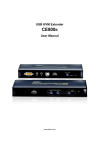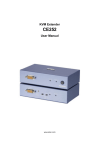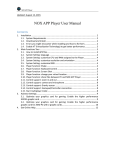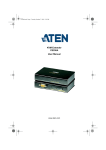Download Digital KVM Extender User Manual
Transcript
Digital KVM Extender CE790 User Manual www.aten.com CE790 User Manual FCC Information This is an FCC Class A product. In a domestic environment this product may cause radio interference in which case the user may be required to take adequate measures. This equipment has been tested and found to comply with the limits for a Class A digital device, pursuant to Part 15 of the FCC Rules. These limits are designed to provide reasonable protection against harmful interference when the equipment is operated in a commercial environment. This equipment generates, uses and can radiate radio frequency energy and, if not installed and used in accordance with the instruction manual, may cause harmful interference to radio communications. Operation of this equipment in a residential area is likely to cause harmful interference in which case the user will be required to correct the interference at his own expense. RoHS This product is RoHS compliant. SJ/T 11364-2006 The following contains information that relates to China. ii CE790 User Manual User Information Online Registration Be sure to register your product at our online support center: International http://support.aten.com North America http://www.aten-usa.com/product_registration Telephone Support International 886-2-8692-6959 China 86-10-5255-0110 Japan 81-3-5323-7178 Korea 82-2-467-6789 North America 1-888-999-ATEN ext 4988 United Kingdom 44-8-4481-58923 User Notice All information, documentation, and specifications contained in this manual are subject to change without prior notification by the manufacturer. The manufacturer makes no representations or warranties, either expressed or implied, with respect to the contents hereof and specifically disclaims any warranties as to merchantability or fitness for any particular purpose. Any of the manufacturer's software described in this manual is sold or licensed as is. Should the programs prove defective following their purchase, the buyer (and not the manufacturer, its distributor, or its dealer), assumes the entire cost of all necessary servicing, repair and any incidental or consequential damages resulting from any defect in the software. The manufacturer of this system is not responsible for any radio and/or TV interference caused by unauthorized modifications to this device. It is the responsibility of the user to correct such interference. The manufacturer is not responsible for any damage incurred in the operation of this system if the correct operational voltage setting was not selected prior to operation. PLEASE VERIFY THAT THE VOLTAGE SETTING IS CORRECT BEFORE USE. This ATEN product is specifically designed and manufactured for the operation and management of computer mainframe and communications equipment used in network management centers. As such, it may not be completely appropriate for those environments and sites where special standards for performance and high reliability are required – such as military equipment, traffic management, nuclear facilities, security systems, communications equipment, medical facilities, etc. iii CE790 User Manual Package Contents The CE790 Digital KVM Extender package consists of: 1 CE790T Digital KVM Extender (Transmitter) 1 CE790R Digital KVM Extender (Receiver) 1 USB KVM Cable (CE790T) 2 Power Adapters 2 Rack Mount Kits 2 Grounding Wires 1 User Manual* 1 Quick Start Guide Check to make sure that all the components are present and that nothing got damaged in shipping. If you encounter a problem, contact your dealer. Read this manual thoroughly and follow the installation and operation procedures carefully to prevent any damage to the unit, and/or any of the devices connected to it. * Features may have been added to the CE790 since this manual was printed. Please visit our website to download the most up-to-date version. © Copyright 2009–2010 ATEN® International Co., Ltd. Manual Part No. PAPE-0310-AT2G Manual Date: 2010-06-25 ATEN and the ATEN logo are registered trademarks of ATEN International Co., Ltd. All rights reserved. All other brand names and trademarks are the registered property of their respective owners. iv CE790 User Manual Contents FCC Information . . . . . . . . . . . . . . . . . . . . . . . . . . . . . . . . . . . . . . . . . . . . . ii RoHS. . . . . . . . . . . . . . . . . . . . . . . . . . . . . . . . . . . . . . . . . . . . . . . . . . . . . . ii SJ/T 11364-2006. . . . . . . . . . . . . . . . . . . . . . . . . . . . . . . . . . . . . . . . . . . . . ii User Information . . . . . . . . . . . . . . . . . . . . . . . . . . . . . . . . . . . . . . . . . . . . .iii Online Registration . . . . . . . . . . . . . . . . . . . . . . . . . . . . . . . . . . . . . . . .iii Telephone Support . . . . . . . . . . . . . . . . . . . . . . . . . . . . . . . . . . . . . . . .iii User Notice . . . . . . . . . . . . . . . . . . . . . . . . . . . . . . . . . . . . . . . . . . . . . .iii Package Contents. . . . . . . . . . . . . . . . . . . . . . . . . . . . . . . . . . . . . . . . . . . iv Contents . . . . . . . . . . . . . . . . . . . . . . . . . . . . . . . . . . . . . . . . . . . . . . . . . . . v About this Manual . . . . . . . . . . . . . . . . . . . . . . . . . . . . . . . . . . . . . . . . . . . vii Conventions . . . . . . . . . . . . . . . . . . . . . . . . . . . . . . . . . . . . . . . . . . . . . . .viii Product Information. . . . . . . . . . . . . . . . . . . . . . . . . . . . . . . . . . . . . . . . . .viii 1. Introduction Overview . . . . . . . . . . . . . . . . . . . . . . . . . . . . . . . . . . . . . . . . . . . . . . . . . . . 1 Features . . . . . . . . . . . . . . . . . . . . . . . . . . . . . . . . . . . . . . . . . . . . . . . . . . . 2 Requirements . . . . . . . . . . . . . . . . . . . . . . . . . . . . . . . . . . . . . . . . . . . . . . . 3 Consoles . . . . . . . . . . . . . . . . . . . . . . . . . . . . . . . . . . . . . . . . . . . . . . . . 3 Computers . . . . . . . . . . . . . . . . . . . . . . . . . . . . . . . . . . . . . . . . . . . . . . . 3 Cables . . . . . . . . . . . . . . . . . . . . . . . . . . . . . . . . . . . . . . . . . . . . . . . . . . 3 Video Resolutions . . . . . . . . . . . . . . . . . . . . . . . . . . . . . . . . . . . . . . . . . 4 Components . . . . . . . . . . . . . . . . . . . . . . . . . . . . . . . . . . . . . . . . . . . . . . . . 5 CE790T (Transmitter) Front View . . . . . . . . . . . . . . . . . . . . . . . . . . . . . 5 CE790R (Receiver) Front View . . . . . . . . . . . . . . . . . . . . . . . . . . . . . . . 6 CE790T / CE790R Rear View . . . . . . . . . . . . . . . . . . . . . . . . . . . . . . . . 7 Side View . . . . . . . . . . . . . . . . . . . . . . . . . . . . . . . . . . . . . . . . . . . . . . . 7 2. Hardware Setup Rack Mounting . . . . . . . . . . . . . . . . . . . . . . . . . . . . . . . . . . . . . . . . . . . . . . 9 Installation . . . . . . . . . . . . . . . . . . . . . . . . . . . . . . . . . . . . . . . . . . . . . . . . . 11 Grounding . . . . . . . . . . . . . . . . . . . . . . . . . . . . . . . . . . . . . . . . . . . . . . 11 Setting Up a Point-to-Point Installation . . . . . . . . . . . . . . . . . . . . . . . . 13 Point-to-Point Installation Diagrams . . . . . . . . . . . . . . . . . . . . . . . . . . 14 CE790T / CE790R Rear View . . . . . . . . . . . . . . . . . . . . . . . . . . . . 14 CE790T Front View . . . . . . . . . . . . . . . . . . . . . . . . . . . . . . . . . . . . 15 Setting Up a Networked Installation . . . . . . . . . . . . . . . . . . . . . . . . . . 16 Networked Installation Diagram . . . . . . . . . . . . . . . . . . . . . . . . . . . . . 18 CE790T / CE790R Rear View . . . . . . . . . . . . . . . . . . . . . . . . . . . . 18 3. Operation Overview . . . . . . . . . . . . . . . . . . . . . . . . . . . . . . . . . . . . . . . . . . . . . . . . . . 19 LED Display . . . . . . . . . . . . . . . . . . . . . . . . . . . . . . . . . . . . . . . . . . . . . . . 19 Invoking the OSD . . . . . . . . . . . . . . . . . . . . . . . . . . . . . . . . . . . . . . . . . . . 19 v CE790 User Manual OSD Main Screens . . . . . . . . . . . . . . . . . . . . . . . . . . . . . . . . . . . . . . . . . . 20 CE790T . . . . . . . . . . . . . . . . . . . . . . . . . . . . . . . . . . . . . . . . . . . . . . . . 20 CE790R. . . . . . . . . . . . . . . . . . . . . . . . . . . . . . . . . . . . . . . . . . . . . . . . 20 OSD Navigation . . . . . . . . . . . . . . . . . . . . . . . . . . . . . . . . . . . . . . . . . . . . 21 OSD Functions . . . . . . . . . . . . . . . . . . . . . . . . . . . . . . . . . . . . . . . . . . . . . 22 Video Quality (CE790T only). . . . . . . . . . . . . . . . . . . . . . . . . . . . . . . . 22 Speaker. . . . . . . . . . . . . . . . . . . . . . . . . . . . . . . . . . . . . . . . . . . . . . . . 22 Mic. . . . . . . . . . . . . . . . . . . . . . . . . . . . . . . . . . . . . . . . . . . . . . . . . . . . 22 Destination (CE790T only) . . . . . . . . . . . . . . . . . . . . . . . . . . . . . . . . . 23 Source (CE790R only) . . . . . . . . . . . . . . . . . . . . . . . . . . . . . . . . . . . . 24 Configuration. . . . . . . . . . . . . . . . . . . . . . . . . . . . . . . . . . . . . . . . . . . . 25 Return . . . . . . . . . . . . . . . . . . . . . . . . . . . . . . . . . . . . . . . . . . . . . . . . . 26 Default IP Addresses . . . . . . . . . . . . . . . . . . . . . . . . . . . . . . . . . . . . . . . . 26 OSD Function Summary. . . . . . . . . . . . . . . . . . . . . . . . . . . . . . . . . . . . . . 27 CE790T . . . . . . . . . . . . . . . . . . . . . . . . . . . . . . . . . . . . . . . . . . . . . . . . 27 CE790R. . . . . . . . . . . . . . . . . . . . . . . . . . . . . . . . . . . . . . . . . . . . . . . . 27 4. The Firmware Upgrade Utility Before You Begin . . . . . . . . . . . . . . . . . . . . . . . . . . . . . . . . . . . . . . . . . . . 29 Starting the Upgrade. . . . . . . . . . . . . . . . . . . . . . . . . . . . . . . . . . . . . . . . . 30 Upgrade Succeeded . . . . . . . . . . . . . . . . . . . . . . . . . . . . . . . . . . . . . . . . . 30 Appendix Safety Instructions . . . . . . . . . . . . . . . . . . . . . . . . . . . . . . . . . . . . . . . . . . 31 General . . . . . . . . . . . . . . . . . . . . . . . . . . . . . . . . . . . . . . . . . . . . . . . . 31 Rack Mounting . . . . . . . . . . . . . . . . . . . . . . . . . . . . . . . . . . . . . . . . . . 33 Technical Support. . . . . . . . . . . . . . . . . . . . . . . . . . . . . . . . . . . . . . . . . . . 34 International . . . . . . . . . . . . . . . . . . . . . . . . . . . . . . . . . . . . . . . . . . . . 34 North America . . . . . . . . . . . . . . . . . . . . . . . . . . . . . . . . . . . . . . . . . . . 34 Specifications . . . . . . . . . . . . . . . . . . . . . . . . . . . . . . . . . . . . . . . . . . . . . . 35 Troubleshooting . . . . . . . . . . . . . . . . . . . . . . . . . . . . . . . . . . . . . . . . . . . . 36 Overview . . . . . . . . . . . . . . . . . . . . . . . . . . . . . . . . . . . . . . . . . . . . . . . 36 About SPHD Connectors . . . . . . . . . . . . . . . . . . . . . . . . . . . . . . . . . . . . . 36 Limited Warranty. . . . . . . . . . . . . . . . . . . . . . . . . . . . . . . . . . . . . . . . . . . . 36 vi CE790 User Manual About this Manual This User Manual is provided to help you get the most from your system. It covers all aspects of installation, configuration and operation. An overview of the information found in the manual is provided below. Chapter 1, Introduction, introduces you to the CE790 system. Its purpose, features and benefits are presented, and its front and back panel components are described. Chapter 2, Hardware Setup, describes the steps that are necessary to quickly and safely set up your installation. Chapter 3, Operation, explains the fundamental concepts involved in operating the CE790 system, and provides a complete description of the CE790T and CE790R’s On Screen Displays (OSDs) and how to work with them. Chapter 4, The Firmware Upgrade Utility, explains how to use this utility to upgrade the CE790’s firmware with the latest available versions. An Appendix, provides specifications and other technical information regarding the CE790. vii CE790 User Manual Conventions This manual uses the following conventions: Monospaced Indicates text that you should key in. [] Indicates keys you should press. For example, [Enter] means to press the Enter key. If keys need to be chorded, they appear together in the same bracket with a plus sign between them: [Ctrl+Alt]. 1. Numbered lists represent procedures with sequential steps. ♦ Bullet lists provide information, but do not involve sequential steps. → Indicates selecting the option (on a menu or dialog box, for example), that comes next. For example, Start → Run means to open the Start menu, and then select Run. Indicates critical information. Product Information For information about all ATEN products and how they can help you connect without limits, visit ATEN on the Web or contact an ATEN Authorized Reseller. Visit ATEN on the Web for a list of locations and telephone numbers: viii International http://www.aten.com North America http://www.aten-usa.com Chapter 1 Introduction Overview The CE790 is an IP based KVM Extender with automatic cable detection (Auto MDIX) and RS-232 serial functionality that allows access to a computer system from a remote USB console (USB keyboard, monitor, and USB mouse) anywhere on the intranet. The CE790 system consists of a transmitter (CE790T) that connects to the computer system and a receiver (CE790R) that is located on the user’s desk. Because it allows access to the computer system from the remote console via a standard TCP/IP network, the CE790 is perfect for use in any type of installation where you need to place the console where it is conveniently accessible, but you want the system equipment to reside in a safe location – away from the dust and dirt of the factory floor, or the harsh environmental influence of a construction site, for example. The CE790 is also useful for control and security purposes, where you can have the system unit in a secure area at the same time that you put the console in the most convenient location for user access. This is ideal for managing highly confidential data systems. The CE790 improves on previous designs by: 1) the addition of an intuitive On Screen Display (OSD) on both the transmitter and receiver units for easy setup and operation; 2) working over a standard TCP/IP LAN network via inexpensive Cat 5e cable that allows point-to-point, point-to-multipoint, and multipoint-to-multipoint administration without the need for an additional KVM switch; 3) the addition of an RS-232 port, on both the transmitter and receiver Units to connect to a serial terminal for configuration and serial devices such as touchscreens and barcode scanners; 4) the addition of a dedicated KVM port section on the Local Unit so you can simply and easily include a KVM switch in your installation; and 5) featuring a custom ASIC to ensure the utmost in reliability and compatibility. With an OSD, RS-232 support, and Auto MDIX, the CE790 is the most costeffective and convenient way to get a full workstation experience from anywhere on the intranet. 1 CE790 User Manual Features Remotely access computers on your KVM installation via the intranet Dual console operation – control your system from both the transmitter and receiver USB keyboard, monitor, and mouse consoles OSD (On Screen Display) on both the transmitter and receiver units No software required – an HTTP server is embedded in both units USB Keyboard and USB Mouse Ports RS-232 serial ports* – allows you to connect to a serial terminal for configuration, and serial devices such as touchscreens and barcode scanners Audio enabled (stereo speakers and microphone) USB overcurrent detection and prevention High resolution video – up to 1920 x 1080 Supports widescreen formats Ultra-high quality video mode Hot pluggable Rack mountable Firmware upgradable – via web browser Auto MDIX – automatically detects cable type * RS-232 serial ports support Tx/Rx/CTS/RTS signals only. 2 Chapter 1. Introduction Requirements Consoles A VGA, SVGA, SXGA, UXGA, or multisync monitor capable of the highest resolution that you will be using on any computer in the installation Note: If you connect a DDC type monitor to the Transmitter Unit, the monitor that connects to the Receiver Unit must be able to support the highest video resolution that the DDC monitor can provide A USB keyboard Note: You can use different brands and models of USB keyboard on the Transmitter and Receiver Units, but support for multi-function keyboards is limited to the standard 104 keys. A USB mouse Note: You can use different brands and models of mouse on the Transmitter and Receiver Units, but only the left and right mouse buttons and scroll wheel features are supported. Other mouse features are not supported. Computers The following equipment must be installed on each computer that is to be connected to the system: A VGA, SVGA, SXGA, UXGA, or multisync card. USB host controller and Type A USB port. Cables For optimal signal integrity, and to simplify the layout, we strongly recommend that you use the high quality custom USB KVM Cable that is provided with this package. 3 CE790 User Manual Video Resolutions Supported video resolutions are show in the table, below: Resolution 640 x 480p @ Hz Standard 60 IBM VGA 72, 75 VESA 800 x 600p 56, 60, 72, 75 1024 x 768p 60, 70, 75 VESA 1152 x 864p 75 Apple Mac II 1280 x 768p, 960p, 1024p 60 VESA STD 1280 x 1024 75 1360 x 768 60 1152 x 864p 75 1440 x 900p 60 1680 x 1050p 1920 x 1080p 4 Chapter 1. Introduction Components CE790T (Transmitter) Front View 1 2 3 4 OSD SELECT 5 STATUS No. 1 Component KVM Port Section POWER Description The USB KVM cable supplied with the CE790T package that links the CE790T to the computer plugs into these ports. See Installation, page 11, for further details. If you are combining the CE790T with a KVM switch, the USB KVM cable that links to the respective ports on the Console section of the switch plugs into these ports. 2 RS-232 Serial Port This RS-232 serial port is for connecting to a serial terminal. 3 OSD Pushbutton Press this pushbutton to invoke the CE790T’s On Screen Display (OSD). See OSD Functions, page 22 for details. Once the OSD has been invoked, press this pushbutton to cycle the OSD highlight bar through the available options. Press and hold this pushbutton and reset the power to enter firmware upgrade mode. See The Firmware Upgrade Utility, page 29, for details. 4 Select Pushbutton Press this pushbutton to select functions within the OSD menu. See OSD Function Summary, page 27, for details. 6 LEDs The CE790T has two LEDs to indicate Status and Power. See LED Display, page 19, for details. 5 CE790 User Manual CE790R (Receiver) Front View 1 2 3 OSD SELECT 4 STATUS No. Component POWER Description 1 RS-232 Serial Port RS-232 serial devices – such as touchscreens or barcode scanners – plug into this port. 2 OSD Pushbutton Press this pushbutton to invoke the CE790R’s On Screen Display (OSD). See OSD Function Summary, page 27 for details. Press and hold this pushbutton and reset the power to enter firmware upgrade mode. See The Firmware Upgrade Utility, page 29, for details. 6 3 Select Pushbutton Press this pushbutton to select functions within the OSD menu. See OSD Function Summary, page 27, for details. 4 LEDs The CE790R has two LEDs to indicate Status and Power. See LED Display, page 19, for details. Chapter 1. Introduction CE790T / CE790R Rear View 1 2 3 LAN 4 Side View 5 No. Component Description 1 Power Jack The cable from the DC Power adapter connects here. 2 Audio Ports These mini stereo ports are for the speakers (green) and microphone (pink). 3 LAN Port The Cat 5e cable that connects the CE790T and CE790R Units plugs to the TCP/IP LAN plugs in here. 4 Console Ports The unit’s console USB keyboard, monitor, and USB mouse plug into these ports. 5 Grounding Terminal The grounding wire (used to ground the unit) attaches here. See Grounding, page 11, for further details. 7 CE790 User Manual This Page Intentionally Left Blank 8 Chapter 2 Hardware Setup 1. Important safety information regarding the placement of this device is provided on . Please review it before proceeding. 2. Make sure that the power to all devices connected to the installation are turned off. You must unplug the power cords of any computers that have the Keyboard Power On function. Rack Mounting For convenience and flexibility, the CE790T and CE790R can be mounted on system racks. To rack mount a unit do the following: 1. Using the screws provided in the Rack Mount Kit, screw the mounting bracket into the top or bottom of the unit as show in the diagram below: Phillips hex head M3 x 8 9 CE790 User Manual 2. Screw the bracket into any convenient location on the rack. Note: These screws are not provided. We recommend that you use M5 x 12 Phillips Type I cross, recessed type screws. 10 Chapter 2. Hardware Setup Installation Grounding To prevent damage to your installation it is important that all devices are properly grounded. 1. Use the two grounding wires supplied with this package to ground both units by connecting one end of the wire to the grounding terminal, and the other end of the wire to a suitable grounded object. 2. Make sure that the computer that the CE790T connects to and the monitor that the CE790R connects to are properly grounded. LAN OSD SELECT STATUS POWER 11 CE790 User Manual 3. For increased grounding protection, use STP (shielded twisted pair) cable to connect the Local and Remote Units. There are two methods that can be used: a) In addition to the eight paired wires, STP cable also contains a grounding wire. Solder this wire to the RJ-45 connector as shown in the diagram below: b) The second method is to use the STP cable shielding for grounding. In this case, make sure that the shielding makes tight contact with the top inside of the RJ-45 connector as shown in the diagram below: In either case, make sure that the sides of the RJ-45 connector make tight contact with the grounding contacts on the sides of the RJ-45 socket as shown in the diagram below: 12 Chapter 2. Hardware Setup Setting Up a Point-to-Point Installation Setting up the CE790 Digital KVM Extender system in a point-to-point configuration is simply a matter of plugging in the cables. Note: In a point-to-point configuration, no administrator setup of the CE790T or the CE790R is necessary. Make sure that all the equipment to be connected up is powered Off. Refer to the installation diagrams on the following pages and do the following: 1. At the transmitter site, plug the cables from the console devices (mouse, keyboard, monitor, microphone, speakers) into their ports on the Console section on the rear of the CE790T transmitter. Each port is marked with an appropriate icon to indicate itself. 2. Plug the appropriate connectors on the USB KVM cable supplied with this unit into their ports on the KVM section on the front of the CE790T transmitter. 3. Plug the connectors on the other end of the USB KVM cable into the appropriate ports on the computer. Each connector is marked with an appropriate icon to indicate which it is. Note: If you are combining the CE790 with a KVM switch, the other end of the USB KVM cable plugs into the appropriate console ports on the KVM switch. 4. For control of serial devices, connect the RS-232 serial port on the transmitter to a serial port on the computer. 5. Connect one end of a Cat 5e cable to the CE790T's LAN port (located on the rear of the unit). 6. Plug one of the power adapters (supplied with this package) into an AC source; plug the adapter's power cable into the CE790T's Power Jack 7. Next, at the receiver site, plug the cables from the receiver console devices (mouse, keyboard, monitor, speakers. microphone), into their ports on the Console section of the CE790R. 8. Connect the other end of the Cat 5e cable to the CE790R's LAN port (located on the rear of the unit). 9. Plug the second power adapter (supplied with this package) into an AC source; plug the adapter's power cable into the CE790R's Power Jack. 13 CE790 User Manual Point-to-Point Installation Diagrams CE790T / CE790R Rear View Cat 5e cable 5 CE790T LAN 6 1 Cat 5e cable 8 CE790R LAN 9 14 7 Chapter 2. Hardware Setup CE790T Front View OSD SELECT STATUS 4 2 POWER Local PC 3 USB KVM cable Note: The serial port on the CE790T connects to the computer; the serial port on the CE790R (not shown) connects to a serial device (optional). 15 CE790 User Manual Setting Up a Networked Installation Setting up the CE790 Digital KVM Extender system in a networked configuration allows point-to-point, point-to-multipoint, and multipoint-tomultipoint operation by connecting multiple CE790Ts and CE790Rs over the same TCP/IP LAN. Note: 1. The CE790T/CE790R units are preconfigured with factory-default network settings. If you install only one CE790 Digital KVM Extender system (that is, one CE790T and one CE790R), you do not need to change these default network settings. See Default IP Addresses, page 26, for further details. 2. In a networked configuration with multiple units on the same TCP/IP LAN, each CE790T/CE790R unit must be configured with a unique IP address. See Configuration, page 25, for further details. 3. In multipoint configurations, the IGMP function of your network switches/hubs must be enable to avoid the deterioration of data throughput. Make sure that all the equipment to be connected up is powered Off. Refer to the installation diagram on the following page and do the following: 1. At the transmitter site, plug the cables from the console devices (mouse, keyboard, monitor, microphone, speakers) into their ports on the Console section on the rear of the CE790T transmitter. Each port is marked with an appropriate icon to indicate itself. 2. Plug the appropriate connectors on the USB KVM cable supplied with this unit into their ports on the KVM section on the front of the CE790T transmitter. 3. Plug the connectors on the other end of the USB KVM cable into the appropriate ports on the computer. Each connector is marked with an appropriate icon to indicate which it is. 4. For control of serial devices, connect the RS-232 serial port on the transmitter to a serial port on the computer. 5. Use a Cat 5e cable to connect the CE790T's LAN port (located on the rear of the unit) to the TCP/IP LAN. 6. Plug one of the power adapters (supplied with this package) into an AC source; plug the adapter's power cable into the CE790T's Power Jack 16 Chapter 2. Hardware Setup 7. Next, at the receiver site, plug the cables from the console devices (mouse, keyboard, monitor, speakers. microphone), into their ports on the Console section of the CE790R. 8. Connect the other end of the Cat 5e cable to the CE790R's LAN port (located on the rear of the unit). 9. Plug the second power adapter (supplied with this package) into an AC source; plug the adapter's power cable into the CE790R's Power Jack. 10. Use the OSD to configure the network settings for the CE790T and then the CE790R. See OSD Functions, page 22, for details. 11. Repeat these steps for each CE790T / CE790R you wish to install on the TCP/IP LAN. 17 CE790 User Manual Networked Installation Diagram CE790T / CE790R Rear View Cat 5e cable 5 CE790T LAN 6 1 TCP/IP LAN Cat 5e cable 8 CE790R LAN 9 7 Note: See p. 15 for the CE790T front view installation diagram. 18 Chapter 3 Operation Overview This section provides a description of the procedures involved in the configuration and operation of your CE790 installation, including how to use the On Screen Display (OSD). LED Display Both the CE790T transmitter and CE790R receiver units have front panel LEDs to indicate their operating and power status, as shown in the table, below: LED Status Indication Lights GREEN when LAN is connected. Off when LAN is not connected. Blinks GREEN when Ethernet is active. Lights Orange to indicate large network bandwidth (ultra-high video) is being used. Power OFF when power is off. Lights GREEN when the unit is powered on and a network connection is established. Light RED when the unit is powered on but there is no network connection. Invoking the OSD The On Screen Display (OSD) is a keyboard-driven menu-based method to handle control and configuration operations. Both the CE790T transmitter and the CE790R receiver units have OSDs. All procedures start from the OSD main screen. To invoke the OSD, either press the OSD pushbutton on the front of the unit, or tap the Scroll Lock key twice. Note: You can change the OSD invocation hotkey to the left or right [Ctrl] keys. See Configuration, page 25 for details. The Ctrl keys must be both left, or both right. 19 CE790 User Manual OSD Main Screens When you invoke the OSD, screens similar to the ones below appears: CE790T CE790R 20 Chapter 3. Operation OSD Navigation Action Method Using the CE790T / CE790R Pushbuttons Use the OSD pushbutton on the front of the unit to cycle the OSD highlight bar through the available options. When your option is highlighted, press the Select pushbutton. Using the Keyboard Use the Up and Down Arrow keys to move the OSD highlight bar up or down. Use the [Page Up]/[Page Down] keys to move to the next or previous menu level. When your option is highlighted, press [Enter]. Using the Function Keys In some menu levels, you can use the Function buttons (F1–F6 for the CE790T, F1–F5 for the CE790R) to select a menu option. The highlight bar moves straight to the option you have selected. Then, press [Enter]. Exiting the OSD To exit the OSD, press [Esc] on the keyboard or move the OSD highlight bar to RETURN on the OSD main menu page and press the Select pushbutton on the front of the unit. The OSD disappears and your computer desktop screen is displayed. 21 CE790 User Manual OSD Functions Video Quality (CE790T only) The CE790 allows you to transmit low/normal/high/ultra high video quality images. To set the video quality, do the following: 1. Invoke the OSD (See Invoking the OSD, page 19). 2. Select Video Quality from the main menu. The sub-menu appears. 3. Select Low, Normal, High, or Ultra High from the sub-menu to set the video quality you require. Note: 1. The default setting is Normal. 2. Compression ratio = original picture size / compressed picture size. Low: 15–25; Normal: 7–12; High: 6–8; Ultra-High: 1–3. Speaker To turn the speakers on or off, do the following: 1. Invoke the OSD (See Invoking the OSD, page 19). 2. Select Speaker from the main menu. The sub-menu appears. 3. Select On or Off from the sub-menu to turn the speakers on or off. Note: The default setting is On. Mic To turn the microphone on or off, do the following: 1. Invoke the OSD (See Invoking the OSD, page 19). 2. Select Mic from the main menu. The sub-menu appears. 3. Select On or Off from the sub-menu to turn the microphone on or off. Note: The default setting is On. 22 Chapter 3. Operation Destination (CE790T only) This option allows you to connect the CE790T transmitter(s) to one or many CE790R receiver units (i.e.. the destination) in point-to-point and point-tomultipoint configurations over the TCP/IP LAN. Note: 1. To set the network topology, see [insert cross ref] 2. The CE790T network settings should be configured before the CE790R(s). See Configuration, page 25, for details. To set the CE790T’s destination, do the following: 1. Invoke the OSD (See Invoking the OSD, page 19). 2. Select Destination from the main menu. The sub-menu appears. 3. Select from the following options: None – no CE790R is selected; disconnect from all CE790Rs. IP – allows you to connect to a specific IP address. Key in a valid IP address and press [Enter]. 23 CE790 User Manual Source (CE790R only) This option allows you to connect the CE790R receiver(s) to a CE790T transmitter unit (i.e.. the source) in the point-to-point configurations over the TCP/IP LAN that you have already set up on the CE790T. Note: The CE790T network settings should be configured before the CE790R(s). See Configuration, page 25, for details. To set the CE790R’s source, do the following: 1. Invoke the OSD (See Invoking the OSD, page 19). 2. Select Source from the main menu. The sub-menu appears. 3. Select from the following options: None – no CE790T is selected; disconnect the CE790T. Source List – a further sub-menu appears allowing you to Connect to or Disconnect from a specific CE790T in a point-to-point configuration, or to Return to the previous menu level. Note: The Source List is refreshed according to the Duration setting. See Configuration, page 25. IP – allows you to connect to a specific IP address. Key in a valid IP address and press [Enter]. 24 Chapter 3. Operation Configuration This option allows you to configure the CE790T/CE790R, including configuring the IP address and subnet mask, renaming a unit on the TCP/IP LAN, setting the duration, and setting the OSD invocation hotkeys. Note: 1. The CE790T/CE790R units are preconfigured with factory-default network settings. If you install only one CE790 Digital KVM Extender system (that is, one CE790T and one CE790R), you do not need to change these default network settings. See Default IP Addresses, page 26. 2. In a networked configuration with multiple units on the same TCP/IP LAN, each CE790T/CE790R unit must be configured with a unique IP address. See IP below for details. To configure the CE790T/CE790R, do the following: 1. Invoke the OSD (See Invoking the OSD, page 19). 2. Select Configuration from the main menu. The sub-menu appears. 3. Select from the following options: IP – allows you to set up the IP address for the CE790T/CE790R. Key in a valid IP address and press [Enter]. Note: See Default IP Addresses, page 26, for the preconfigured factory-default settings. IP Mask – allows you to setup the IP mask for the CE790T/CE790R. Key in a valid IP mask value and press [Enter]. Note: The default setting is 255.255.255.0 Name – allows you to name the CE790T/CE790R. Key in a name using 15 characters or less and press [Enter]. Note: The default name settings are CE790T or CE790R. Duration – allows you to set the refresh rate for the Destination/Source List. Options are 30 / 60 / 300 / 100 secs. Note: The default setting is 60 secs. 25 CE790 User Manual OSD Hotkey – allows you to set the OSD invocation hotkeys. Options are as follows: [Scroll Lock] [Scroll Lock]; [R_Ctrl] [R_Ctrl]; [L_Ctrl] [L_Ctrl] Note: The default setting is [Scroll Lock] [Scroll Lock] Baud Rate – allows you to set the baud rate for the CE790T/CE790R. Options are 9600, 19200, or 38400 bps. Note: Default UART settings are: 9600 bits per second; 8 data bits; no parity; 1 stop bit; with hardware flow control. Topology – allows you to set your network topology. Options are Multi-to-1 and Multi-to-Multipoint. When either option is selected, a reminder screen appears, noting that in multi-point configurations, the IGMP function of your network switches/ hubs should be enabled to avoid deterioration of data throughput. Select Yes to continue selecting the network topology. Note: Topology is a CE790T Transmitter only function. It does not appear as an option in the CE790R OSD. Return Use this option to exit the OSD as follows: use the keyboard to move the OSD highlight bar to RETURN on the OSD main menu page and press the OSD pushbutton on the front of the unit. The OSD disappears and your computer desktop screen will be displayed. Default IP Addresses The preconfigured factory-default IP addresses for the CE790 units are as follows: CE790T – 192.168.168.15 CE790R – 192.168.168.16 26 Chapter 3. Operation OSD Function Summary CE790T Setting VIDEO QUALITY Function Allows you to set the video compression ratio. Note: The default setting is NORMAL. SPEAKER Allows you to turn the audio on/off. Note: The default setting is ON. Allows you to turn the microphone on/off. MIC Note: The default setting is ON. DESTINATION Allows you to connect to or disconnect from a CE790R, connect to a specific IP address, or broadcast to every CE790R on the TCP/ IP LAN. Note: The default settings are NONE selected and CONNECT. CONFIGURATION Allows you configure the IP address and subnet mask of a CE790R, rename a CE790R, set the duration, and set the OSD invocation hotkeys. Note: The default OSD invocation is [Scroll Lock] [Scroll Lock]. BAUD RATE Allows you to set the baud rate. Note: The default setting is 9600. RETURN Allows you to exit the OSD. CE790R Setting SPEAKER Function Allows you to turn the audio on/off. Note: The default setting is ON. MIC Allows you to turn the microphone on/off. Note: The default setting is ON. SOURCE Allows you to connect to or disconnect from a CE790T, connect to a specific IP address, or broadcast to every CE790T on the TCP/IP LAN. Note: The default settings are NONE selected and CONNECT. CONFIGURATION Allows you configure the IP address and subnet mask of a CE790T, rename a CE790T, set the duration, and set the OSD invocation hotkeys. Note: The default OSD invocation is [Scroll Lock] [Scroll Lock]. BAUD RATE Allows you to set the baud rate. Note: The default setting is 9600. RETURN Allows you to exit the OSD. 27 CE790 User Manual This Page Intentionally Left Blank 28 Chapter 4 The Firmware Upgrade Utility New firmware upgrade packages are posted on our Website as new firmware revisions become available. Check the web site regularly to find the latest packages and information relating to them: http://www.aten.com Before You Begin The CE790T/CE790R’s firmware can be easily upgraded (one unit at a time) via web browser. To prepare for the firmware upgrade, do the following: 1. Go to our Internet support site and download the Firmware Upgrade Package for your device (CE790). 2. After the file has been downloaded, reconfigure your computer’s IP address so that it resides on the same network as the CE790T/CE790R. See Default IP Addresses, page 26 for reference. 3. Use a LAN cable to connect the CE790T/CE790R’s LAN port to the LAN port on your computer. 4. Press and hold the OSD pushbutton. 5. While you are holding the OSD pushbutton, plug in the unit’s power cable. 6. Keep holding the OSD pushbutton for a further three seconds. The front panel LEDs flash green alternately to indicate Firmware Upgrade Mode is in effect. 7. Release the OSD pushbutton. 29 CE790 User Manual Starting the Upgrade To upgrade your firmware: 1. Open a web browser and key in the following address: Upgrading the CE790T – http://192.168.168.15/upg.htm Upgrading the CE790R – http://192.168.168.16/upg.htm The Firmware Upgrade screen appears: 2. Click Browse to find the Firmware Upgrade file you have just downloaded. Then click Upgrade. As the Upgrade proceeds, progress toward completion is shown on the Progress bar Note: Upgrading the firmware will take a few minutes, so do not interrupt the process. Upgrade Succeeded After the upgrade has completed, a screen appears to inform you that the procedure was successful: 30 Appendix Safety Instructions General Read all of these instructions. Save them for future reference. Follow all warnings and instructions marked on the device. Do not place the device on any unstable surface (cart, stand, table, etc.). If the device falls, serious damage will result. Do not use the device near water. Do not place the device near, or over, radiators or heat registers. The device cabinet is provided with slots and openings to allow for adequate ventilation. To ensure reliable operation, and to protect against overheating, these openings must never be blocked or covered. The device should never be placed on a soft surface (bed, sofa, rug, etc.) as this will block its ventilation openings. Likewise, the device should not be placed in a built in enclosure unless adequate ventilation has been provided. Never spill liquid of any kind on the device. Unplug the device from the wall outlet before cleaning. Do not use liquid or aerosol cleaners. Use a damp cloth for cleaning. The device should be operated from the type of power source indicated on the marking label. If you are not sure of the type of power available, consult your dealer or local power company. The device is designed for IT power distribution systems with 230V phase-to-phase voltage. To prevent damage to your installation, it is important that all devices are properly grounded. The device is equipped with a 3-wire grounding type plug. This is a safety feature. If you are unable to insert the plug into the outlet, contact your electrician to replace your obsolete outlet. Do not attempt to defeat the purpose of the grounding-type plug. Always follow your local/national wiring codes. Do not allow anything to rest on the power cord or cables. Route the power cord and cables so that they cannot be stepped on or tripped over. 31 CE790 User Manual If an extension cord is used with this device make sure that the total of the ampere ratings of all products used on this cord does not exceed the extension cord ampere rating. Make sure that the total of all products plugged into the wall outlet does not exceed 15 amperes. To help protect your system from sudden, transient increases and decreases in electrical power, use a surge suppressor, line conditioner, or un-interruptible power supply (UPS). Position system cables and power cables carefully; Be sure that nothing rests on any cables. Never push objects of any kind into or through cabinet slots. They may touch dangerous voltage points or short out parts resulting in a risk of fire or electrical shock. Do not attempt to service the device yourself. Refer all servicing to qualified service personnel. If the following conditions occur, unplug the device from the wall outlet and bring it to qualified service personnel for repair. The power cord or plug has become damaged or frayed. Liquid has been spilled into the device. The device has been exposed to rain or water. The device has been dropped, or the cabinet has been damaged. The device exhibits a distinct change in performance, indicating a need for service. The device does not operate normally when the operating instructions are followed. Only adjust those controls that are covered in the operating instructions. Improper adjustment of other controls may result in damage that will require extensive work by a qualified technician to repair. Do not connect the RJ-11 connector marked “UPGRADE” to a public telecommunication network. 32 Appendix Rack Mounting Before working on the rack, make sure that the stabilizers are secured to the rack, extended to the floor, and that the full weight of the rack rests on the floor. Install front and side stabilizers on a single rack or front stabilizers for joined multiple racks before working on the rack. Always load the rack from the bottom up, and load the heaviest item in the rack first. Make sure that the rack is level and stable before extending a device from the rack. Use caution when pressing the device rail release latches and sliding a device into or out of a rack; the slide rails can pinch your fingers. After a device is inserted into the rack, carefully extend the rail into a locking position, and then slide the device into the rack. Do not overload the AC supply branch circuit that provides power to the rack. The total rack load should not exceed 80 percent of the branch circuit rating. Make sure that all equipment used on the rack – including power strips and other electrical connectors – is properly grounded. Ensure that proper airflow is provided to devices in the rack. Ensure that the operating ambient temperature of the rack environment does not exceed the maximum ambient temperature specified for the equipment by the manufacturer. Do not step on or stand on any device when servicing other devices in a rack. 33 CE790 User Manual Technical Support Technical support is available both by email and online (with a browser over the web): International For online technical support – including troubleshooting, documentation, and software updates: http://support.aten.com For telephone support, see Telephone Support, page iii. North America Email Support Online Technical Support [email protected] Troubleshooting Documentation Software Updates Telephone Support http://www.aten-usa.com/support 1-888-999-ATEN ext 4988 When you contact us, please have the following information ready beforehand: Product model number, serial number, and date of purchase. Your computer configuration, including operating system, revision level, expansion cards, and software. Any error messages displayed at the time the error occurred. The sequence of operations that led up to the error. Any other information you feel may be of help. 34 Appendix Specifications Function Connectors CE790T Console Keyboard Ports Video Mouse Speaker Mic. RS-232 KVM Ports LEDs Emulation 1 x HDB-15 Female (Blue) 1 x USB Type A Female (White) 1 x Mini Stereo Jack Female (Green) 1 x Mini Stereo Jack Female (Pink) 1 x DB-9 Male (Black) KB / Video / Mouse 1 x SPHD-17 Female (Yellow) N/A Speaker 1 x Mini Stereo Jack (Green) Mic. 1 x Mini Stereo Jack (Pink) 1 x DC Jack (Black) LAN 1 x RJ-45 Female (Black) OSD 1 x Pushbutton Select 1 x Pushbutton Status 1 (Green / Orange) Power 1 (Green / Red) Keyboard / Mouse Power Consumption Video Environment 1 x USB Type A Female (White) 1 x DB-9 Female (Black) Power Pushbuttons CE790R USB DC 5.3V, 6.62W Up to 1920 x 1080 Operating Temp. 0–50ºC Storage Temp Humidity Physical Properties DC 5.3V, 6.36W -20–60ºC 0–80% RH, Non-condensing Housing Weight Dimensions (L x W x H) Metal 0.504 kg 0.482 kg 20.0 x 8.0 x 2.5 cm 35 CE790 User Manual Troubleshooting Overview Operation problems can be due to a variety of causes. The first step in solving them is to make sure that all cables are securely attached and seated completely in their sockets. Problem Action No video Make sure that all cables are securely plugged into their sockets. Poor quality video Adjust the default video quality setting from Normal to High or Ultra-High using the OSD. SeeVideo Quality (CE790T only), page 22. About SPHD Connectors This product uses SPHD connectors for its KVM and/or Console ports. We have specifically modified the shape of these connectors so that only KVM cables that we have designed to work with this product can be connected. Limited Warranty IN NO EVENT SHALL THE DIRECT VENDOR'S LIABILITY EXCEED THE PRICE PAID FOR THE PRODUCT FROM DIRECT, INDIRECT, SPECIAL, INCIDENTAL, OR CONSEQUENTIAL DAMAGES RESULTING FROM THE USE OF THE PRODUCT, DISK, OR ITS DOCUMENTATION. The direct vendor makes no warranty or representation, expressed, implied, or statutory with respect to the contents or use of this documentation, and especially disclaims its quality, performance, merchantability, or fitness for any particular purpose. The direct vendor also reserves the right to revise or update the device or documentation without obligation to notify any individual or entity of such revisions, or update. For further inquiries, please contact your direct vendor. 36












































